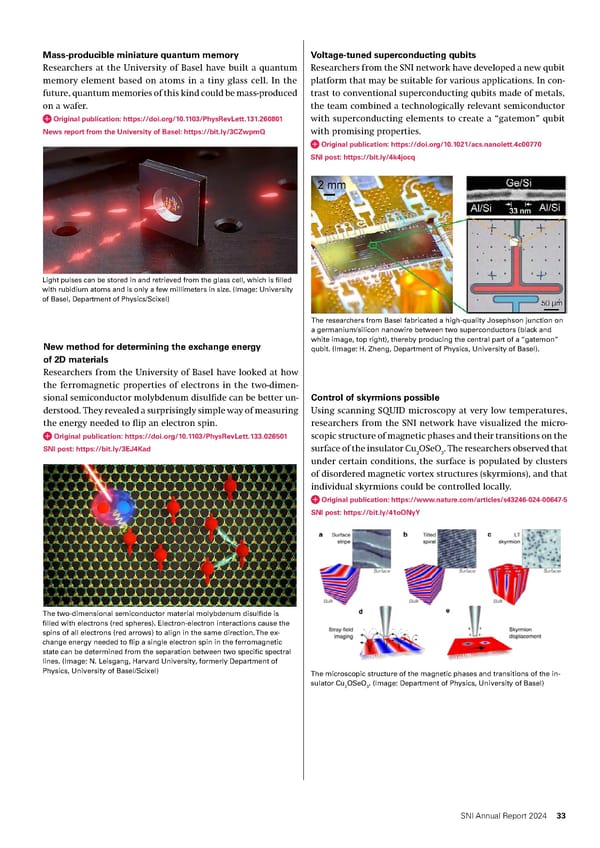Mass-producible miniature quantum memory Voltage-tuned superconducting qubits Researchers at the University of Basel have built a quantum Researchers from the SNI network have developed a new qubit memory element based on atoms in a tiny glass cell. In the platform that may be suitable for various applications. In con- future, quantum memories of this kind could be mass-produced trast to conventional superconducting qubits made of metals, on a wafer. the team combined a technologically relevant semiconductor Original publication: https://doi.org/10.1103/PhysRevLett.131.260801 with superconducting elements to create a “gatemon” qubit News report from the University of Basel: https://bit.ly/3CZwpmQ with promising properties. Original publication: https://doi.org/10.1021/acs.nanolett.4c00770 SNI post: https://bit.ly/4k4jocq Light pulses can be stored in and retrieved from the glass cell, which is filled with rubidium atoms and is only a few millimeters in size. (Image: University of Basel, Department of Physics/Scixel) The researchers from Basel fabricated a high-quality Josephson junction on a germanium/silicon nanowire between two superconductors (black and New method for determining the exchange energy white image, top right), thereby producing the central part of a “gatemon” qubit. (Image: H. Zheng, Department of Physics, University of Basel). of 2D materials Researchers from the University of Basel have looked at how the ferromagnetic properties of electrons in the two-dimen- sional semiconductor molybdenum disulfide can be better un- Control of skyrmions possible derstood. They revealed a surprisingly simple way of measuring Using scanning SQUID microscopy at very low temperatures, the energy needed to flip an electron spin. researchers from the SNI network have visualized the micro- Original publication: https://doi.org/10.1103/PhysRevLett.133.026501 scopic structure of magnetic phases and their transitions on the SNI post: https://bit.ly/3EJ4Kad surface of the insulator Cu OSeO . The researchers observed that 2 3 under certain conditions, the surface is populated by clusters of disordered magnetic vortex structures (skyrmions), and that individual skyrmions could be controlled locally. Original publication: https://www.nature.com/articles/s43246-024-00647-5 SNI post: https://bit.ly/41oONyY The two-dimensional semiconductor material molybdenum disulfide is filled with electrons (red spheres). Electron-electron interactions cause the spins of all electrons (red arrows) to align in the same direction. The ex- change energy needed to flip a single electron spin in the ferromagnetic state can be determined from the separation between two specific spectral lines. (Image: N. Leisgang, Harvard University, formerly Department of Physics, University of Basel/Scixel) The microscopic structure of the magnetic phases and transitions of the in- sulator Cu OSeO . (Image: Department of Physics, University of Basel) 2 3 SNI Annual Report 2024 33
 Annual Report 2024 - Swiss Nanoscience Institute Page 32 Page 34
Annual Report 2024 - Swiss Nanoscience Institute Page 32 Page 34